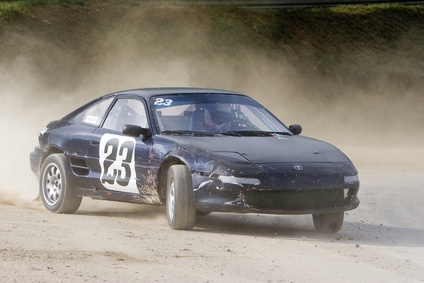
Oversteer describes what occurs when the back end of a vehicle slides towards the outside of the turn due to the rear tires losing grip while the front tires keep their grip on the road. Understeer is what occurs when the front tires wash out towards the outside of the turn, while the rear tires continue to grip the road. The most desirable cornering state is one that is neutral, since understeer can cause a loss of speed and severe oversteer can be difficult to control and dangerous. There are a few steps one can take to reduce oversteer.
Adjust the tire pressure. Tire pressure has a big impact on how a car's tires behave during cornering and can cause oversteer as well as understeer, depending on the settings. Start by inflating the tires to the manufacturer's recommended settings. If the vehicle is still oversteering, reduce the air in the front tires by a few PSI--which will reduce grip--and add air to the rear tires--which will increase grip and help the rear tires resist the tendency to slide around.
Install wider, stickier (softer compound) tires on the back, which will increase the grip from the rear end during cornering and reduce the tendency of the car to oversteer.
Adjust the shocks or install different shocks. If you have adjustable shocks, stiffen the front shocks and set the rear shocks to a looser setting. A softly sprung rear suspension will generally oversteer less than a very stiff suspension. If your car does not have adjustable shocks, then install softer rear shocks in place of the shocks that are currently installed.
Stiffen the springs and the anti-roll bar at the front, and reduce the stiffness of the springs and anti-roll bar at the rear. Like the shocks, the springs and anti-roll bar also contribute to how stiff a suspension is. Reducing the stiffness of the springs at the rear will help a car oversteer less. The same goes for the anti-roll bar. A smaller rear anti-roll bar combined with a larger front bar will reduce oversteer and increase understeer. These changes should be done incrementally so that you don't end up with a car that has terminal understeer, which can also be undesirable.
Adjust the alignment settings. Your car's alignment can also have a big impact on the behavior of the suspension. Too much front negative camber will increase oversteer, so reducing the amount of camber (the angle that that tires tilt in or out) will increase understeer. The toe settings also have an impact. Have a professional alignment shop perform the alignment after explaining the suspension's behavior to them and what you want to accomplish.
Raise the front end and lower the rear end. With the rear end closer to the ground, the car will have a tendency to oversteer less with a lower center of gravity.